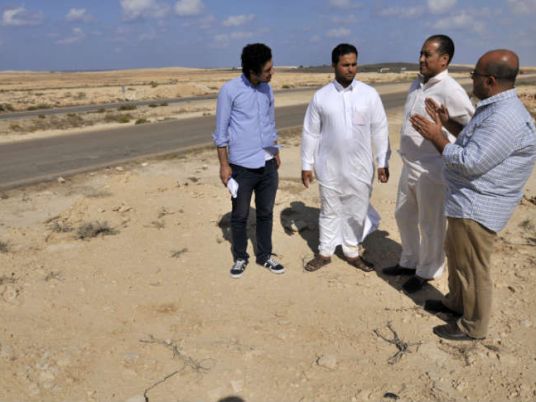
Over three consecutive decades, and under different governments, official promises had been made to achieve Egypt’s nuclear energy dream, the latest was by incumbent president Abdel Fattah al-Sisi, who pledged to revive the project that has been stalled for 32 years.
In 1981, former president Mohamed Hosni Mubarak decreed the allocation of lands at al-Dabaa region, 400 km west of Cairo, for the implementation of Egypt’s first electricity-generating nuclear station. In 1986, the tender for the reactor’s construction was halted after Russia’s Chernobyl reactor catastrophe.
Al-Masry Al-Youm visited the al-Dabaa site to show readers the latest developments related to the project.
Adjacent one-story buildings spread across 6,500 meters owned by the Egyptian Atomic Energy Agency (EAEA). An arid plot of land lay void of any signs related to the project except for a signboard bearing the name of the Engineering Authority of the Armed Forces (EAAF) as the entity supervising the works of El Alamen, a 15-year-old contracting company owned by Farag Shoteib, who belongs to the tribes of Matrouh province.
Hamdy al-Gharib is the officer charged by El Alamen with executing the housing units for engineers who would operate the nuclear station. Gharib stresses that work has been 80 percent completed on the engineers’ housing scheme, which has been in works since May and scheduled to finish in November.
LE20 million have been spent on the the first phase of the housing project which will include 20 villas. The units will also host maintenance workshops for equipment used in the nuclear station, according to Gharib, who noted that three other companies are working side by side with El Alamen to set up administrative offices and garages.
Five hundred meters away from the city of Dabaa, the project is constantly overseen by military personnel. “The contracting company cooperates with the EAAF in all technical and financial issues. The Ministry of Electricity was merely in charge of handing over its lands to the Armed Forces,” Gharib explains.
Speaking about the selection of El Alamen to carry out the housing scheme, Gharib said the Armed Forces took into consideration the social dimension and opted for the company whose chief belongs to Marsa Matrouh tribes, and which also enjoys well-known financial and technical capabilities.
The area designed the the nuclear project is divided into three sections, the eastern part of which is planned to host eight reactors. In the western section, several administrative, technical and engineering offices. The remaining plots will be allocated as a compensation for civilians affected by the undertaking.
Five kilometers away from the engineers’ accommodations lies the suggested site of the nuclear reactor, where there are no signs of workers or construction operations. According to Gharib, that piece of land is military-owned, run by the EAAF and not assigned for any contractor company, but construction will begin in that area as part of the second phase.
In January 2012, the people of Dabaa invaded the nuclear station’s site and vandalized its 12,300-acre-long and 2-meter-high wall, despite that it had been provided with watch towers and barbed wires. “The people of Dabaa had been enduring constant problems and disregard by the Egyptian government, most notably that they have not been enrolled in military academies over the past period,” Mohamed Saeed Saleh, a senior member of Dabaa’s Abu Shkara family, said. He, however, noted that, thanks to mediation efforts and settlements achieved by the Armed Forces, which heeded social dimensions, there have been no intentions among citizens to stir trouble again.
Ibrahim al-Eseiry, a nuclear energy expert, said Dabaa remains the best location for installing the nuclear station, adding that studies prior to the selection of that site had lasted for 30 years, and that Egypt had lost nearly LE522 billion as a result of delaying the project. Eseiry said that the establishment of the nuclear facility in Dabaa would help offset the scarcity of natural gas and petroleum resources, as well as the difficulty of relying on solar and wind power alone.
“A residential project presented by the Armed Forces to the people of Dabaa, with a cost of LE1 billion,” this was the suggestion offered by President Abdel Fattah al-Sisi to absorb the anger of Dabaa’s bedouins when he was defense minister under former president Mohamed Morsy.
Five kilometers away from the reactor’s planned site are 2,383 acres allocated for the construction of a residential project for the people of Dabaa, which is to stretch along a 2-km public beach along the Mediterranean for the first time.
Al-Masry Al-Youm met with Mastour Abu Shkara, coordinator of a local committee of Dabaa residents who was the second party in negotiations with the Armed Forces that sought to resolve the standoff between the state and locals. “A deal was reached on 30 September 2013, after we had submitted eight requests to the Armed Forces. Those included the establishment of a 5-km-long beach, which was approved by then defense minister Abdel Fattah al-Sisi,” said Abu Shkara. He added that Sisi visited them last October and said he was coming to express gratitude for the people of Dabaa by announcing the new residential town.
At that time, Abu Shkara relates, it was planned that 1,500 housing units would be designed according to the Bedouin style of architecture which citizens opted for personally, besides schools, markets and mosques.
“Under former president Mohamed Morsy, several Muslim Brotherhood leaders mediated on behalf of the government with the citizens of Dabaa,” says Abu Shkara. “Mohamed al-Beltagy (a senior Brotherhood leader), came to Matrouh on 23 August to discuss our demands for the 2012 Constitution. We told him we were ready to hand over the nuclear station’s lands without any conditions and that we would not receive any compensations, but there was no answer from officials. We met the ousted president in Matrouh and called upon him not to proceed with the nuclear project in return for handing the lands over. We also visited him at the Ettehadiya presidential palace and offered to give up the lands for more than three times, but he never gave us any attention.”
Abu Shkara remembers the first time negotiations with the army began. “It began when the head of military intelligence in Matrouh came to Dabaa to resolve the crisis that followed the burning of its police station. He sat down with tribal leaders who narrated the history of the dispute over the nuclear site.” Abu Shkara says, adding that the intelligence chief gave them the freedom to either to wait until a parliament is elected and therefore entrust it to resolve the crisis or to seek a resolution immediately.
The rounds of intensive negotiations, according to Abu Shkara, tackled a set of demands by the citizens. “We demanded the study on the station’s lands to be redone, lawsuits by the Ministry of Electricity to be dropped and priority in job appointments to be given to the damaged citizens of Dabaa after the nuclear project is finished,” Abu Shkara explains. “We also demanded to grant the citizens fair compensation for the lands grabbed for the project based on a presidential decree in 1981.”
The people of Dabaa also wanted the security siege imposed on the project’s site to be removed, and a part of the plot to be allocated for establishing a public beach for them. Abu Shkara said Sisi had approved all the demands.
A written agreement was signed on 23 September 2013, Abu Shkara says, and on 30 September, a social reconciliation with the state was sealed whereby the local police station was renovated and reopened.
People have given the name of Abdel Fattah al-Sisi to the town designed for their residence, according to Abu Bakr al-Garary, a Salafi leader in Dabaa and a member of the popular committee, who said he had proposed the name as a sort of appreciation.
Edited translation from Al-Masry Al-Youm




